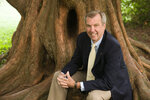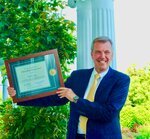



Chestnut Hill resident Paul W. Meyer, retired executive director of Morris Arboretum & Gardens whose groundbreaking work in horticulture blooms in habitats around the world, from small row-house gardens to expansive tree-lined arboretums, died at home on Oct. 10 of complications from pancreatic cancer. He was 71.
In a career spanning more than four decades, Meyer led the arboretum as the Chestnut Hill institution expanded, increased attendance, introduced new species and attractions, and bolstered participation in horticultural scholarship.
“It would be no overstatement to say that during Paul’s 43-year tenure at the Morris, 28 years as its leader, he transformed a quiet garden on the edge of the city into a vibrant, world-class public institution,” said Bill Cullina, who succeeded Meyer as the arboretum’s F. Otto Haas executive director. “Paul’s love and commitment to the Morris is felt in every acre. We give Paul our deepest thanks for leaving us this beautiful, irreplaceable public garden.”
Meyer was an international leader in the field of plant exploration and evaluation. Throughout his career, he made 12 expeditions to collect and analyze plants from countries all over the world – including China, Korea, Taiwan, Armenia and the Republic of Georgia – and introduced a greater genetic diversity of plants now thriving throughout the mid-Atlantic region. Most recently, in 2022, he traveled to Uzbekistan and Tajikistan.
In 2022, Meyer was awarded the Veitch Memorial Medal, an international prize issued annually by the Royal Horticultural Society in Great Britain and widely considered to be the most prestigious honor in the field. First issued 153 years ago, the prize is awarded to "persons of any nationality who have made an outstanding contribution to the advancement and improvement of the science and practice of horticulture."
A beloved partner, friend and neighbor
While Meyer’s national and international reputation centered on his professional work, his many friends and neighbors in the Chestnut Hill area knew him as an unassuming and gentle presence in the community, and someone who could always be counted on to help.
“Paul was so incredibly thoughtful, compassionate, and loving. He really cared so much about people,” said his wife, Debra Rodgers, whom he met while the two were in their 20s and then later married. “He was also very adventurous – we had so much fun together. We took so many amazing trips and traveled all over the world. It was an amazing life we had and I feel lucky to have lived it with him.”
According to those who knew and worked with him, Meyer brought a similar spirit to all his relationships.
“Paul was kindness and generosity personified,” said Anne McNiff, executive director of the Chestnut Hill Community Association. “Whether it was tending to the trees that needed pruning on the Avenue or taking the time to give me personal advice on my ailing zucchini plants, he was always willing to help.”
In 1999, Meyer helped start the Chestnut Hill Garden District Fund. He became co-chair of the group’s Pocket Parks Committee, along with his friend Susan Peck, and together they led efforts to transform Cliff Park, Peace Park, and Memorial Park as well as the green spaces around the signs welcoming visitors to Chestnut Hill.
"From the bottom of his feet to the top of his head — and he was a tall guy, so that’s a long distance — Paul believed in access to gorgeous green spaces for all people. How lucky were we to have him as a neighbor in Chestnut Hill, a neighborhood that he helped make into one of the most beautiful in the world,” said Emily Daeschler, president of the fund. “Paul was a scientist, a humanitarian and a natural leader who worked extraordinarily hard at all three of those things, and unlike many people with those attributes, he was also unfailingly warm, accessible and generous with his time and unparalleled expertise."
Meyer also was an active member of Friends of Pastorius Park, where he helped tend a wide variety of native plants. He coaxed several local arborists to donate much-needed work on a number of heritage trees.
“Without Paul’s vision and passion for the park’s restoration, Pastorius Park would not be the stunning success that it is today,” said Tracy Gardner, current president of the group. “His placement of new trees and native shrubs, including many more beautiful flowering plants that have improved upon Fred Peck’s wonderful original design has created a seasonal dynamism in the park that is a joy to experience at any time of the year.”
And Meyer didn’t just give advice; he came ready to work. He removed invasives, whacked weeds, watered the park and mowed its out-of-the-way corners.
“Even as his health and energy declined,” Gardner said. “Paul made every effort to get out to the park to do something,” including watering planting beds while he sat and rested in a lawn chair.”
A love for landscaping
Meyer grew up in a Cincinnati suburb and his grandparents, who lived nearby, owned an orchard.
“We did not have a lot of money, so I had to bring in some money,” Meyer said in a 2022 interview with the Local. “So I cut grass, did gardening, painted houses, etc. I did not like the painting, but I loved the gardening. It became my passion.” Even as a 6-year-old, he grew his own tomatoes
Meyer attended Ohio State University, planning to study engineering, but when he discovered students could actually major in horticulture, he switched to that.
After graduation, Meyer earned a summertime position at Hillier Gardens and Arboretum in Winchester, England. “I was looking through books of English gardens and thought, wouldn’t it be nice to go to England,” he said in the 2022 interview. “Encouraged by my professors, I wrote to Harold Hillier.”
Hillier, a leading horticulturist who was knighted in 1971 for his work in the field, hired Meyer.
“I worked for peanuts, about $50 a week,” Meyer said. “After taxes, 7.5 pounds (about $18). I went to experience another culture but also because England is the motherload of gardens.”
Meyer completed his time in Europe with a stint at a garden in Hildesheim, Germany, before coming home to enter the University of Delaware’s Longwood Graduate Program at Longwood Gardens in Chester County. There, he met people affiliated with Morris Arboretum, who at the time, in the mid-1970s, were working to boost its spotty attendance. He was hired as director of horticulture and a curator in 1976.
“When I started, the word 'horticulturist' did not command a lot of respect among the public,” Meyer said in the 2022 interview. “People would say, 'Oh, that's a gardener, right?' It did not get the same respect as other professions.”
Similarly, Meyer said, an arboretum wasn’t exactly the kind of place career-minded professionals would expect to spend their entire work life.
“It was considered an entry-level place,” he said, “but after I was hired right out of grad school, a kind of baby curator, they hired a dynamic executive director, Bill Klein.”
Klein held that position from 1977 to 1990, and in 1991, after a nationwide search, Meyer was selected to become the arboretum’s new director.
“I was on the search committee to find a new director, and I knew about the major financial problems the arboretum had. They offered the job to someone else, and he turned it down. Then the search committee asked me to do it. I thought if I didn't take it, I would be at the mercy of someone else, and I thought I could come up with a sound financial plan,” Meyer said. “It turned out to be the year from hell. After a few months, we had a tornado-like storm, which destroyed hundreds of trees and made matters even worse, but the community really rallied, and donations poured in. It has been improving ever since then.”
Thanks to the efforts of Meyer and others, attendance increased, along with the arboretum’s award-winning reputation. Before the pandemic, about 140,000 people visited Morris annually, and attendance increased substantially even after the pandemic began.
Alongside his leadership of the arboretum, Meyer taught urban horticulture in the University of Pennsylvania’s Landscape Architecture and Regional Planning Department and was a frequent contributor to horticultural publications. He was a co-author of “Philadelphia Trees: A Field Guide to the City and the Surrounding Delaware Valley” ( 2017). It was just updated and republished in January of this year.
Catriona Briger, a contributor to the book, said Meyer's deep knowledge about - and enthusiasm for - the region’s tree canopy remains a living legacy.
“I love thinking of all the trees he had a hand in planting, living on in his memory,” she said. Meyer’s scholarly work was, in part, a product of his belief that research and education were foundational to the arboretum’s mission. He built up the institution’s botanical staff, as well as its reputation for regional floristic studies.
Meyer retired from the arboretum in 2019, but he remained passionate about inspiring future generations of public garden leaders. He and his wife personally endowed two funds at the Morris: The Paul Meyer and Debra L. Rodgers Study-Travel Endowment, and the Paul Meyer and Debra L. Rodgers Historic Preservation Endowment Fund – both of which have been supplemented by contributions from other donors.
Meyer also was an accomplished photographer and often was seen walking the grounds of Morris Arboretum with a camera in his hands. His photographic acumen is documented in the volume “Morris Arboretum Through the Lens of Paul W. Meyer,” which showcases the arboretum grounds in all four seasons.
In reflecting on Meyer’s life, career and friendship, Gardner said, she’ll treasure the quiet joy he took in the natural world, and his talent for sharing it.
“His delight in the flock of cedar waxwings that took up residence in the park this summer, in a precocious bud on one of our new pawpaws, or in the late-summer flowering of the park’s Franklinia trees was infectious – as was his excited reports of rainwater amounts after storms,” Gardner said. “We will miss him something awful.”